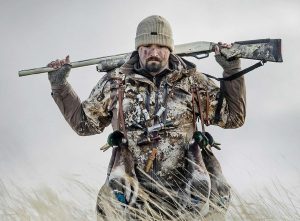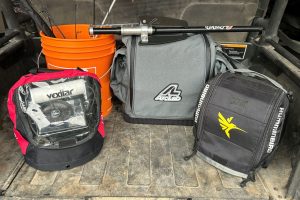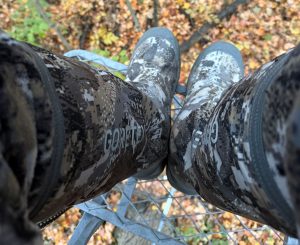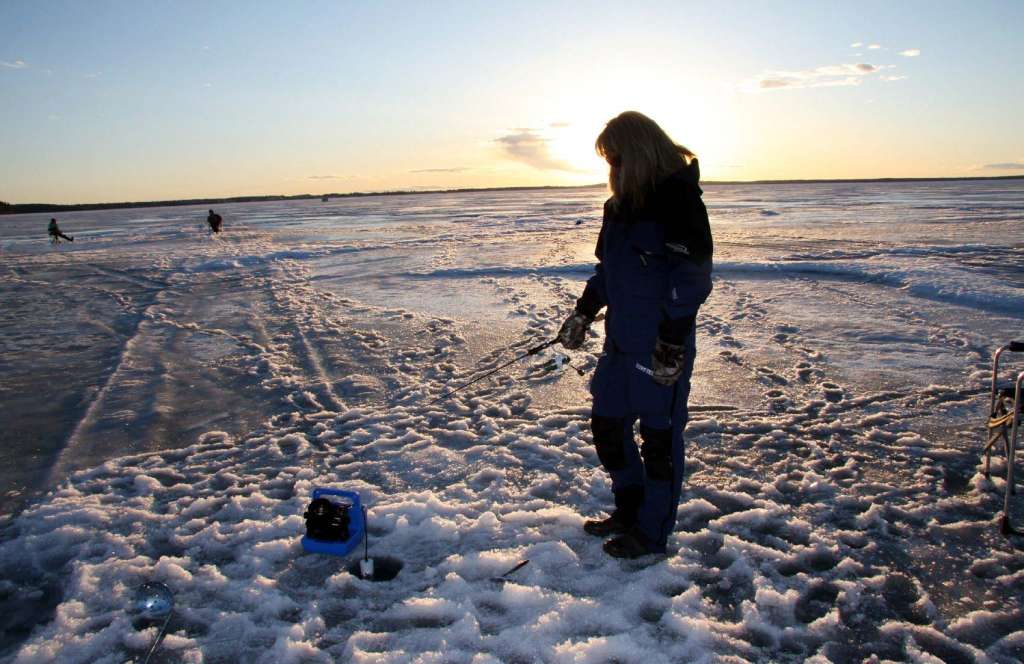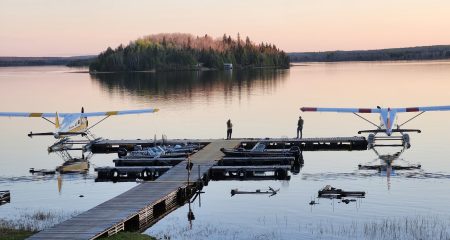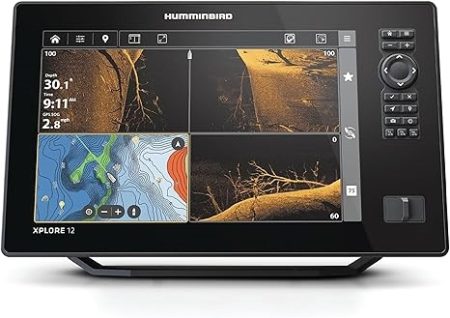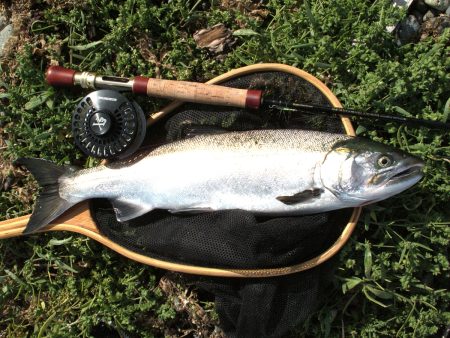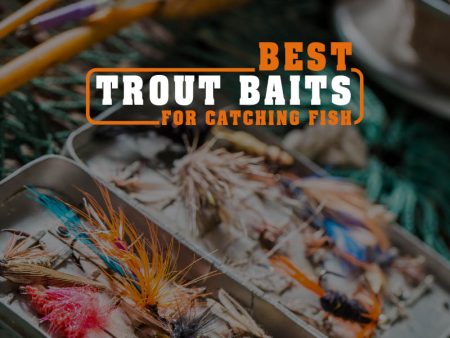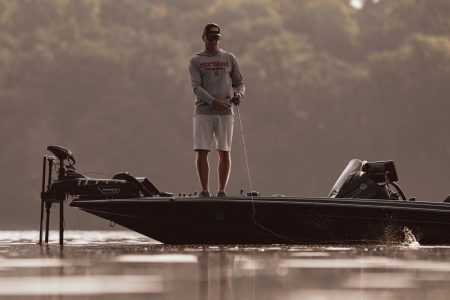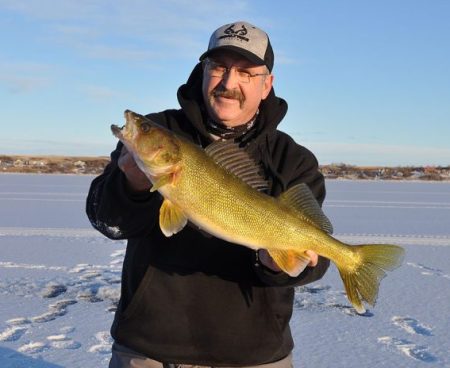Lake trout can be caught all winter long, but savvy anglers know that the waning days of the ice fishing season can produce some of the best action of the year.
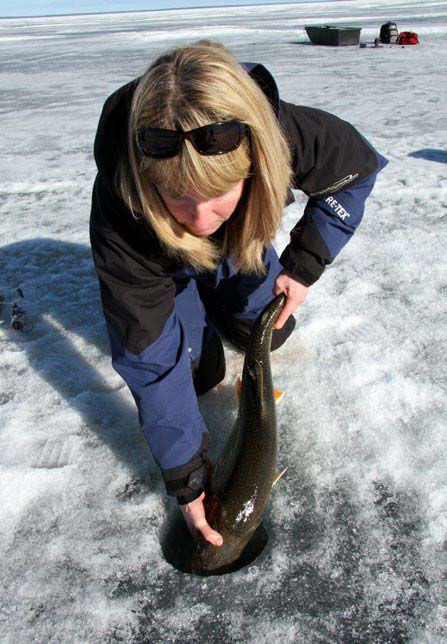
Beelining for a shelf 200 metres off shore, we wasted no time firing up the auger to punch a series of holes into the ice. The top crust was soft, but below was still a substantial layer of solid. Eager to wet a line, our party of six cleared the holes and scurried to rig sonars and flashers, then plunged our offerings to a depth of 75 feet. Probing a pronounced transition where the depth fell quickly from 40 to 80 feet, the structure was perfect for intercepting lake trout on the prowl for ciscoes and other baitfish.
It didn’t take long, and my buddy, Fred Noddin, hollered, “fish on!” A hungry trout had taken his tube jig and was now fighting to escape! Careful to reel in slowly because of the depth, several minutes later, a fine six-pound Laker was iced, then quickly and carefully released to be caught another day.
As the sun sets on another hardwater season, lake trout always get my vote. Potentially precarious ice, locating structure and forage, and probing the deep water in search of voracious predators – these are the quintessential ingredients for scoring on late season Lakers.
I love ice fishing, especially during the waning days of the hardwater season. As the late March sun eats away at the ice, the thaw is imminent. Warmer temperatures, and an intensifying sun cause heat waves to shimmer across the surface. Adding to the magic of late season ice-fishing, the bite can often be fast and furious! While so many turn their focus to lake whitefish or pre-spawn walleye and pike, one of my favourite species to target during the closing days of the season is lake trout. Allow me to share with you the reasons why, and a few tips to help you tie into your own late ice Lakers.
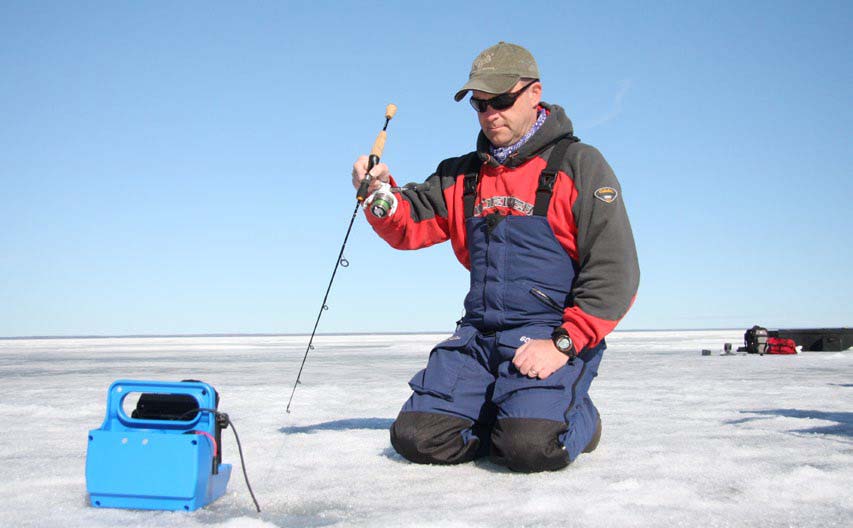
Target Cruising Fish
By description, lake trout are eager and willing fish. Predators of the deep, they are constantly on the move. Yes, we can identify structure and fish nearby areas where we find baitfish, but ice fishing lake trout is less about targeting the spot on the spot, and more about capitalizing on densities of cruising fish. Most often found in smaller schools of two or three individuals, as sight feeders, they are always on the prowl for whitefish, ciscoes, shiners, smelt, and even yellow perch. With this in mind, electronics are an asset for locating baitfish. Find congregations of baitfish and the lake trout will surely be lurking nearby.
One of my favourite lake trout fisheries is Alberta and Saskatchewan’s shared Cold Lake. Renowned not only for its high numbers of trout, it also has a reputation for producing size; giants that often tip the scale at over 20-pounds.
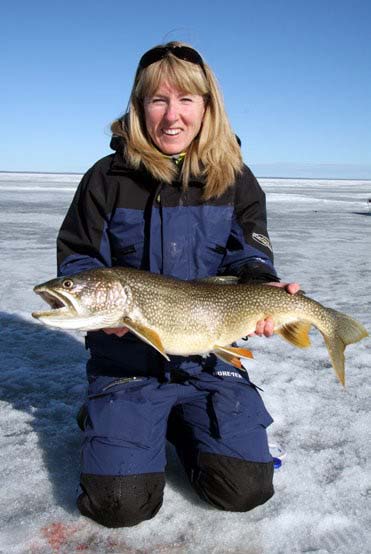
Depth & Structure
Most lake trout fisheries are big and deep. If you know the hydrography of your favourite lake, great – but as a rule, before any ice fishing trip, especially for lake trout, it’s always beneficial to do some research. Search the internet for intel, ask questions at tackle shops, and talk with local anglers to gather information about where to begin looking for them. Tight-lipped anglers aside, ask enough people and someone will eventually offer some valuable information.
Take time to study a hydrographic map. As an esteemed member of the char family, Salvelinus namaycush, is aptly named. Salvelinus is an old name for char, and namaycush is an Ojibwe name literally meaning “dweller of the deep”. If we take this as a literal hint, we acknowledge that lake trout spend most of their time in the deeper, colder, waters of any given fishery. Why do they prefer deeper water? Mostly because they do best in colder water temperatures that hover between 4 °C (40 °F) and 10 °C (50 °F).
Pinpointing a productive area to fish can be the most challenging element we face when fishing for late ice lake trout. Sometimes they’ll be right on the bottom, sometimes at shallower depths, and sometimes suspended. Rest assured though, whatever depth you find them at, its because there are baitfish nearby.
Electronics & Fish Finding
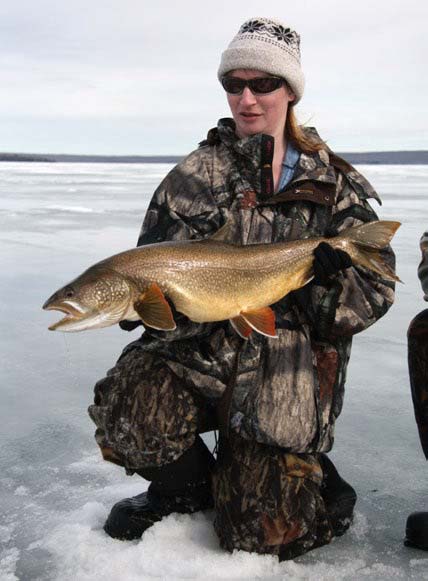
Vertical fishing for lake trout through a hole in the ice is mostly about scanning and probing different depths to determine where they are hanging out. Each lake can be a bit different and, especially with late ice, experimenting with variable depths is often in order. After a long winter, baitfish like ciscoes, shiners, and smelt may be found higher up in the water column, close to the light where they are feeding on micro-organisms. In turn, lake trout will follow.
Lake trout hang out near structure. They are more cruisers than stationary ambushers. While a pike often tucks in under the cover of a log or in the tall weeds to wait for unsuspecting baitfish to swim by, a lake trout is constantly on the move scanning for enticing baitfish like ciscoes or shiners that they can chase down and corral against a steep wall or some other type of structure. To choose a prime location to begin searching for lake trout, consider the sharper drop-offs, elevated shoals, humps, and ridges between sunken islands. One thing I’ve learned about lake trout is that if you find them in an area one time, you are likely to find them hanging out in that area year after year.
During the late ice month of March, most lake trout are still lingering deep. I’ve heard of anglers targeting lake trout in the eastern provinces at depths of 10 to 40 feet with great success, especially in the early season. In the mid-west provinces, whether you’re fishing a mountain lake or a larger waterbody in northern boreal regions, deeper water is usually key for these handsome trout.
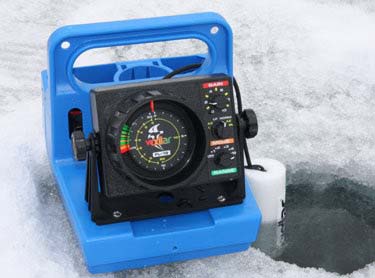
Even in deeper water, I typically look for ledges or sharp contrasts in depth where the bottom transitions quickly from say 60 feet immediately down to 80 or 90 feet. For this very reason, electronics are imperative for ice fishing lake trout. At minimum, a quality sonar that provides an accurate depth reading along with baitfish and potential target fish is a must and a quality flasher is perhaps even more important for ice fishing deep water lake trout. I use a Vexilar FL-8SE. Functional to 120 feet of water, with a three-color display, it is very easy to use and helps identify depth and approaching fish.
Gear
Gear selection is always a matter of personal choice. Where I like to fish lakers, we tie into lots of threeto- seven lb. trout, but we also catch a good number in the 10-15 lb. range as well, and there is always the chance of catching something even bigger. For this reason, I’m a firm believer in upsizing my rod, reel and line just in case.
While heavier action spinning reels will suffice, for ice-fishing I like to use both shorter medium action icefishing rods as well as full-size 7’- 9’ rods. Armed with either level-wind or jigging reels. As a rule, I spool each with at least 10-lb. braided line, and up to 25-lb. test fluorocarbon leaders. My favourite lake trout rig is a one-piece 30” medium action Daiwa Triforce 301MFS jigging rod married with a Shimano Stradic 2500FJ spinning reel.
For lake trout, my go-to lure is either a white or yellow tube jig armed with a smaller minnow. The size of jig head I choose is generally proportionate to the size of tube I’m using, the size of fishing I’m targeting, and the depth I’m fishing. They can range from as small as ¼ ” all the way up to 1 oz. in size. Berkley Power Tubes and Exude both make exceptional scented soft plastics.

Presentations
Lake trout can be voracious feeders. When one strikes, it is likely that a small school is moving through, so be sure to capitalize on the flow of traffic below your hole. With plenty of lure choices available on the market, my favourites include scent-impregnated Gulp tube jigs – but I’d be remiss if I didn’t mention a few other top lake trout ice fishing lures including the Williams Whitefish spoons, airplane jigs, white marabou jigs, and Luhr Jensen blade baits. Remember, lake trout are attracted to motion. Any movement that closely resembles a wounded or dying baitfish is ideal.
In my experience, where regulations allow, bait is a must for lake trout. They are on the prowl, and the scent given off by a shiner, herring, anchovy, or sucker belly is most often too much to ignore. While many anglers believe in using bigger herring or anchovy on their hook in hopes of attracting a larger fish, I’ve learned that bigger spot-tail shiners can be equally effective. In some situations, small-to- medium size Parker minnows on a YUM YUMbrella Money Head jig can be more than a Laker can resist.

Tube jigs spiral down to their depth and move in a rotational pattern when jigged. At depth I first work my line fairly aggressively every minute or so, and then raise and drop the line – taking care to control the slack, all-the-while observing the line for any abnormal behavior indicating a strike. Most takes seem to be on the drop, so it is common to miss a strike. If you see your line tighten, stop, or behave oddly, don’t wait, set the hook and reel immediately. At greater depths, it is easy to miss a strike and lose lake trout when a fraction of a second can mean losing a fish. The key with jigging for trout in deeper water is maintaining consistent movement to attract them. While most anglers drop their presentation and fish the bottom, it can sometimes be better to slowly work your offering up and fish different depths, even mid-way up the water column. Lake trout are notorious for swimming upward to chase bait. As long as a lake trout can see your offering, they will often attack and suck it in just before you raise the rod tip again.
In direct contrast, one of my fishing partners likes to run stationary lines with something comparable to a Carolina rig right near the bottom. He sees success with this relatively motionless presentation baiting his hooks with either a piece of sucker belly or a herring.
Handle With Care
Because lake trout are commonly caught at greater depths, atmospheric pressure is a big deal and it often kills fish when they are brought to the surface too quickly, handled rough, and released improperly. When fish are hooked at greater depths, take care to bring them up slowly. If they are brought on to the ice too fast, their swim bladder fills up and can ultimately kill them. This is of particular concern when size restrictions come into play and fish must be released.
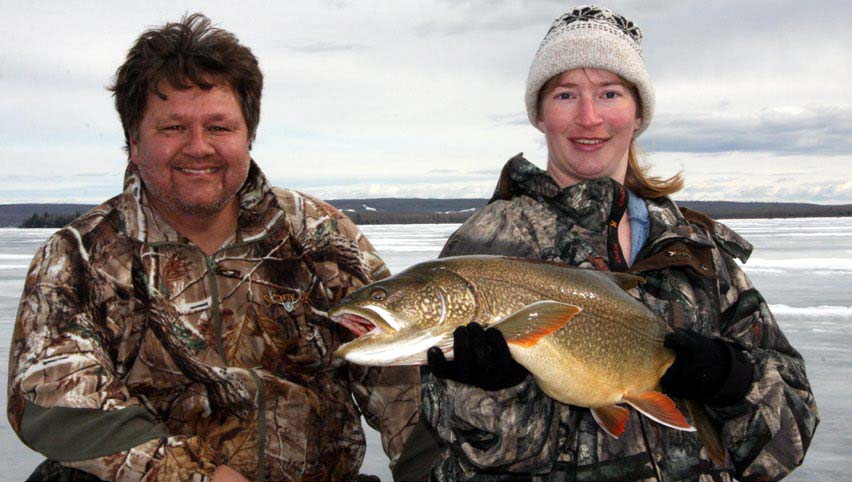
Safety First
Regardless of timing, ice safety should always be top-of-mind, but late ice can be particularly precarious. It is a concern on any lake fishing for any species, but especially when we’re dealing with deep water, hyper diligence is in order.
Always exercise extreme caution when venturing out on the last ice of the year. Know that the sun is becoming increasingly intense and rotting the hardwater by the day. In many areas the ice melts earlier in March, but conditions are everything. Be sure to check with local tackle shops and listen for official fishing reports. Pay attention to conditions at access points. Recognize that the ice around the edges usually thaws first. If you have to drive through water at the access point, its best use extreme caution. Keep an eye out for ice heaves where there may be dangerous ice conditions. Sometimes its smarter to leave your truck on dry land and either walk on or use an ATV or Snow machine.
By Kevin Wilson
Per our affiliate disclosure, we may earn revenue from the products available on this page. To learn more about how we test gear, click here.

